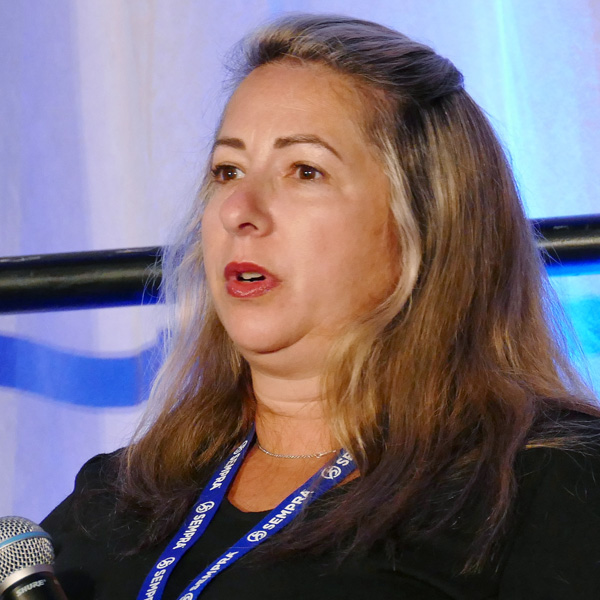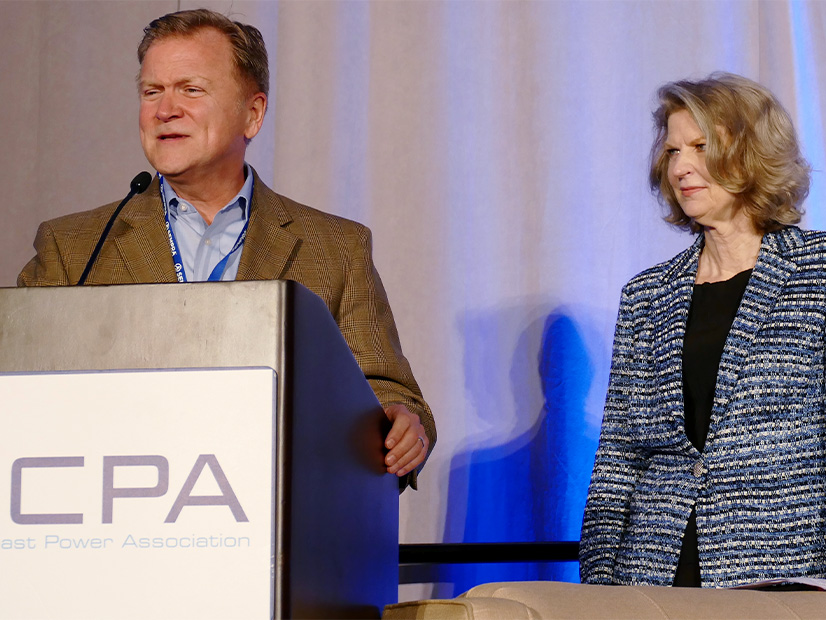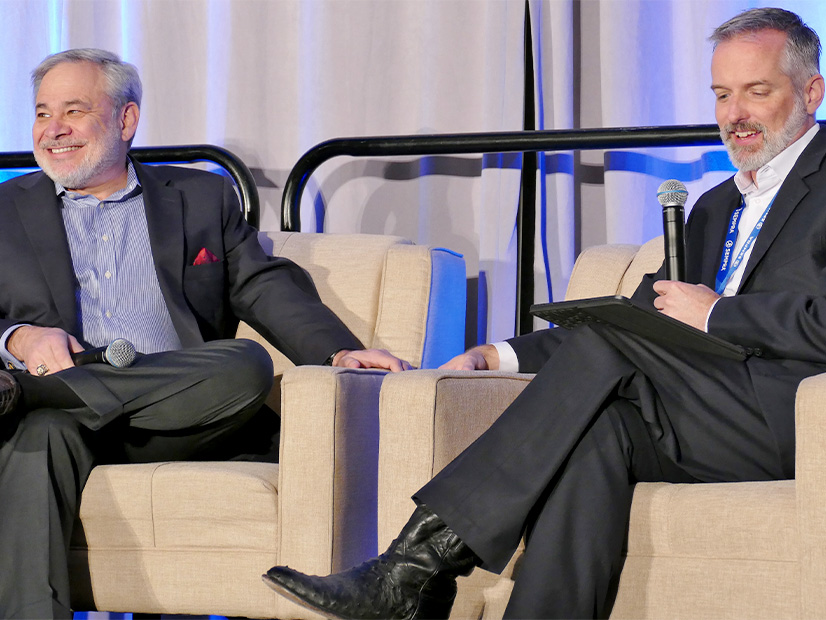
Market Participants Frustrated with ERCOT’s Market Redesign
HOUSTON — The Gulf Coast Power Association drew more than 400 attendees to its first in-person Spring Conference, and 35th overall, since 2019 and “that thing,” as GCPA President Mark Dreyfus referred to the COVID-19 pandemic.
A pair of panels discussing regulatory and market changes since the February 2021 winter storm brought the ERCOT grid within minutes of a total collapse kicked things off. Panelists expressed frustration with the pace of change and the uncertainties of future market designs.
Michele Richmond, executive director of lobbying group Texas Competitive Power Advocates (TCPA), said her members want to be compensated for the weatherization requirements and other obligations that have been placed on them.
“We focused on reliability, which was good early on for many years, but what we’ve seen is a shift to command and control,” she said. “There’s an unwillingness to let the market commit resources. We’ve seen a lot of mandates placed on generators, which we understand in terms of winterization and resiliency, but that is largely uncompensated so far.”
Richmond called for a reliability standard, saying ERCOT’s conservative approach to operations and heavy use of reliability unit commitments “have not done anything to incentivize new investment in ERCOT’s dispatchable fleet.”
“That hasn’t done anything to incentivize existing resources, many of which are marginal,” she said. “When the wind’s not blowing and the sun not’s shining, you definitely want my members to turn on. The economics for gas plants don’t work. No one wants to lend you money to do that. Until we have a market that allows full recovery on dispatchable generation costs, we’ll continue to see problems.”
Bryan Sams, Calpine’s executive vice president of governmental regulations, said the Texas Public Utility Commission’s lowering of the operating reserve demand curve’s system cap from $9,000/kWh to $5,000/kWh has been among several changes that have sent a dampening signal to the market and is taking money out of it.
WattBridge’s Tina Lee agreed, saying, “We haven’t seen the price impacts ripple through the market. For generators, we think the market signals have been muted, not only by ERCOT’s conservative operations approach, but the other revenue channels’ dispatchable generation needs. You want to incent new generation, not keep older generation around.”
“Historically, in an energy-only market, all revenue comes from the market itself and a small portion from ancillary services,” AB Power Advisors’ Matthew Berend said. “Now, we’ve gone to an approach where there’s more value in a smaller part of the market. That doesn’t necessarily translate into more thermal generation being built.”
Last December, the PUC suggested several market designs to be evaluated for the ERCOT market’s second phase of restructuring. Commission Chair Peter Lake asked staff to focus on a backstop reliability service proposal first and then a load-side reliability mechanism that some have likened to a capacity market — a four-letter word in Texas. (See PUC Forges Ahead with ERCOT Market Redesign.)
“All of them have their challenges, and there’s no silver bullet,” Berend said.
“If you’re going to use the ‘c’ word [‘capacity’], you may as well belly up to the bar and say we need a capacity market,” ENGIE’s Bob Helton said.
Jones: Will Stay as Interim CEO
Interim ERCOT CEO Brad Jones declined to use prepared remarks in addressing attendees, opening himself up to questions, but with a catch: only two-word questions.
“Retirement plans?” he was asked.
“Soon. Soon. Very soon,” Jones said. “I have committed to the state, to the PUC, to politicians and others that I will be here as long as they need me, but only as interim CEO. I want to ensure they get that right person into this role.”
Since Jones was chosen to lead ERCOT last April, his retirement plans have slipped from the fall to April, and now to June. According to industry insiders, the grid operator’s Board of Directors has been looking at five to 18 candidates but is having trouble finding someone to fill what has become a political position. (See ERCOT Board Chooses Jones as Interim CEO.)
Responding to the one single-word question he received (“Cryptos?”), Jones said cryptocurrency and Bitcoin miners present a “fantastic” resource to the grid operator. He said the large, energy-intensive data farms used to solve the complex calculations that yield Bitcoin are “very price-responsive” and have the ability to quickly shut down operations, making them effective in balancing supply and demand.
Jones said one crypto load near ERCOT’s control center in Taylor has about 700 MW of load, about half of Austin’s average load. He said when he asked one legislator to imagine half of Austin — one of the deep-blue urban areas in an otherwise red state — disappearing from the grid, the lawmaker cracked, “Wow! That would be pretty cool.”
“We need to work with these folks to bring them in,” said Jones, who is expecting ERCOT’s current crypto load of 1.5 GW to reach 5 GW in two years. “I see that as a positive, but we’ve got to think about some policy issues.”
Jones was unable to provide an answer to “2032 peak?” But he offered a 2022 number: 80 GW. That would shatter ERCOT’s record peak demand of 74.7 GW, set in 2019.
“I believe we have the resources to meet that kind of load. I’m excited about that,” Jones said. He cited the “extraordinary growth” in renewables — 15 to 18 GW in a year — in pushing ERCOT’s renewable capacity to 44 GW.
“As we speak, we expect to have about 28 GW of production from our wind generation,” he said. “California bragged about 18 GW of wind the other day. … Let’s show them our numbers.”
MPs Ask for Continued Stakeholder Involvement
Several panelists brought up their concerns with ERCOT’s stakeholder process, in which the Technical Advisory Committee endorses system changes and market rules before they go to the board.
The new board, completely changed since last year’s storm, has created a Reliability and Markets Committee that some market participants worry will take them out of the governance process.
“The stakeholder process forces collaboration and improves outcomes,” TCPA’s Richmond said. “Our members are experts in running power plants, but not transmission and distribution utilities. Something is missed if you don’t have expertise from other [market] segments. It’s sometimes a messy process, and sometimes we argue … but the outcomes tend to be better. It’s more thought out when you conduct it that way.”
Pedernales Electric Cooperative CEO Julie Parsley, noting she served on the board for all of five months before it was essentially disbanded after the winter storm — “A little coincidental, isn’t it?” she remarked — said market participants need to be involved at the board level.
“There’s a non-electric industry view that market participants being a part of the market process is the fox guarding the henhouse,” she said. “Nothing could be farther from the truth. It’s checks and balances. No one’s going to let anybody rob the henhouse, because we’ll see that. I hope we can maintain that stakeholder interest. When you’re working in the market, you see the functionality of the market.”
“The stakeholder process has always been key. It’s made this market,” ENGIE’s Helton said. “You’re not going to invest if you don’t have a voice and your access. I hope we keep going down a path of strong stakeholder involvement.”
“That puts us all in a tough environment. I can’t tell you where the board will be, but there’s a strong belief in the value of the stakeholder process,” Jones said. “That’s my prediction. It’s just a matter of getting that board into a place of comfort.”
Jones also addressed outage scheduling, “the hot issue of today.” He said the outage windows have become shorter, and with the increase of renewables in the market, the spring and fall shoulder months are also having trouble. On April 18, TAC unanimously rejected an ERCOT-drafted rule that would have complied with 2021 legislation to give the grid operator total control over approving or denying maintenance outages. (See ERCOT Technical Advisory Committee Briefs: April 13, 2022.)
“The discussion in the last several weeks, months in fact, is how many outages can we accept. How many megawatts can we take offline,” he said. “The legislature gave us the ability to approve or deny all generation outages, which leaves all generators in a concerning spot.
“That discussion leaves us at odds on some issues,” Jones said. “ERCOT wants to hold as much control as possible over that, while generators want to control as much as possible, but I believe we’ll get there.”
Brouillette Stresses Energy Balance
Former U.S. Energy Secretary Dan Brouillette, now president of Sempra Infrastructure, said the world is seeing a rebalancing of the energy equation, not just in Europe with Russia’s invasion of Ukraine, but across the globe.
He said he spent much of his time in Europe during the Trump administration warning Germany and other countries that they were too dependent on Russian gas.
Sempra Infrastructure’s Dan Brouillette (left) and Brian Lloyd enjoy a laugh during a “fireside chat.” | © RTO Insider LLC
“We could see what the ultimate goal was on the part of Russia. We recognize now that those admonitions of three to four years ago were correct,” Brouillette said. “Environmental security is very important, but also important is economic security and financial security. You have to balance all three, or else you’ll be in the position Germany is today.”
Asked why the U.S. and its allies haven’t been able to replace the gas coming from Russia, Brouillette said, “We can’t simply snap our fingers and create the enormous facilities to produce natural gas. … We’re going to be somewhat dependent on Russian gas. I just don’t see how we replace that amount of gas in such a short time.”
He said energy transition’s historical arc has always been from less energy to more energy; from less dense energy like wood and biomass, to more dense sources like nuclear power.
“As it gets more dense, it gets cheaper and meets more needs. To grow economies, you need more energy,” Brouillette said. “Whale oil is the only source we’ve taken out of the energy stack over the last 1,000 years. Everything else has been additive. [I’ve] always promoted an all-of-the-above strategy. You need to produce all these sources to keep the economies rolling.”
Nuclear energy should remain a part of that mix, Brouillette said. One of the projects he is proudest of as energy secretary was enriching nuclear fuels.
“This specialized fuel allows the creation of these smaller reactors they’re talking about,” Brouillette said. “It allows for walk-away safe nuclear reactors. If the cooling system goes away, nothing happens. There’s no [radiation] release. The reactor just shuts down.”
Analytics Important to Glotfelty
Saying he never wanted to be a regulator, Jimmy Glotfelty, the newest member of the first four-person PUC, has embraced his role as overseer of the ERCOT market.
“We used to be brother and sister, and now the legislature has given us full regulatory oversight over ERCOT,” Glotfelty said, referring to legislation passed in the wake of the February 2021 winter storm. “We can’t let them be the entire analytical process for the commission. We have to have our own view. We have to be able to build out our own processes and our own thoughts.”
Analytics are important to Glotfelty, who had a previous career as a wind developer. He hit the ground running when confirmed to the PUC, meeting with lawmakers after he had already been sworn in and participating in an ERCOT market redesign workshop.
“The cornerstone of [the market redesign’s second phase] is analytical. We have to have the analytics,” Glotfelty said. “I believe the market had some challenges in February [2021], but I don’t believe the market failed. Components of the market failed. Components of winterization failed. Components of the gas system failed. If analytics prove that we don’t know, we’re going to have to understand a little more of it.
“I’m eager to get into these analytics,” he said. “I’ve been saying this since I got to the commission; it needs to be the cornerstone of how we analyze policies at the PUC.”
Storage Key to ERCOT ‘Pummeling’ the Future
During an afternoon workshop on energy storage and its integration into the market, ERCOT staffer Kenneth Ragsdale remembered the first battery that connected to the system 10 years ago.
“It was 36 MW with about 15 minutes of discharge,” he said. “We registered it as controllable load and generation storage. Unfortunately, we’re still using that workaround, but we are trying to get to a single-model aspect.”
Fast forward a decade and the grid operator has about 1.5 GW of storage capacity either installed or synchronized to the grid. Ragsdale thinks the number could approach 5 GW by year-end.
“We’re pummeling the future here with the rapid integration of wind and solar energy. When you walk into an office and tell people you’re in the storage business, they lean forward,” said Pat Wood, former FERC and PUC chair and now CEO of Hunt Energy Network. “This particular piece of energy storage will absolutely be critical to that. The lack of storage requires us to do a much more complex market design.”
Industry Vet Oswalt Wins Star Award
Vicki Oswalt, a 33-year veteran of the Texas electric industry, was honored by the GCPA’s board as its 2022 recipient of the Pat Wood Power Star Award, given annually for the honoree’s significant contributions toward advancing Texas’ competitive energy markets.
“This award is as much about all the people I’ve worked with than it is about me,” Oswalt said. “I don’t want to name names, or we would be here all day. I really feel I share this award with all of you.”

The award is named for Wood, who presented the award to Oswalt and recalled meeting her when he joined the PUC in 1995. The commission wasted no time in installing Oswalt as the first chief of the newly formed Office of Policy Development.
Oswalt joined the PUC in 1989 as a regulatory analyst. After joining Reliant Energy in 1997, she helped implement Senate Bill 7, which opened ERCOT’s competitive retail market. Oswalt also spent time at Energy Future Holdings and its TXU Energy and Luminant subsidiaries before retiring earlier this year as senior vice president of regulatory affairs for Sharyland Utilities.
The GCPA board also took advantage of the opportunity to present ExxonMobil’s Alexandra Williams with its 2021 emPOWERing Young Professionals Award. The award is presented annually to an individual under the age of 40 who has achieved excellence in the electric power industry. Williams actually won the award last year, but she had laryngitis during GCPA’s 2021 virtual Fall Conference, so she could not verbally accept the award. (See “Industry Leaders Honored,” Overheard at the 2021 GCPA Fall Conference.)
A NERC-certified reliability coordinator, Williams has contracted more than 800 MW of renewable power purchases, and managed the two largest demand response portfolios and more than 15 GW of power generation.




